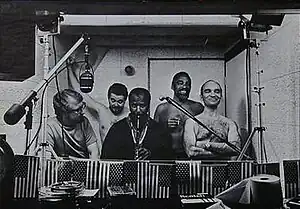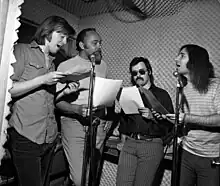
The Credibility Gap was an American satirical comedy team active from 1968 through 1979. They emerged in the late 1960s delivering comedic commentary on the news for the Los Angeles AM rock radio station KRLA 1110, and proceeded to develop more elaborate and ambitious satirical routines on the "underground" station KPPC-FM in Pasadena, California.
Founded as a loose collective centered on KRLA staff members Lew Irwin, John Gilliland, Thom Beck, Richard Beebe, and folk singer Len Chandler, the group is chiefly remembered today for its 1971–79 lineup, comprising Beebe (though early 1975), Harry Shearer, David L. Lander and Michael McKean.[1]
History
Lew Irwin and The Credibility Gap
The Credibility Gap grew out of a company formed by Lew Irwin and Cliff Vaughs.[2][3] KRLA 1110 hired news director Irwin to form The Credibility Gap in 1968 with his radio colleagues John Gilliland, Thom Beck, Richard Beebe, and folk singer Len Chandler.[4] They took their name from the Vietnam-era term "credibility gap" (a euphemism for political dishonesty), and broadcast their comedy along with the news on KRLA. [5] They first aired on the date of the 1968 California Primary.[4] In 1968 (billed as "Lew Irwin and The Credibility Gap") they released An Album Of Political Pornography for Blue Thumb, consisting of highlights from their radio sketches.[6] Thom Beck left in late 1968, and was replaced by Harry Shearer. Lew Irwin left a few months later, replaced by David L. Lander in February, 1969.
The Credibility Gap

In 1969, The Credibility Gap performed on KRLA's Pop Chronicles music documentary.[7][8] By this point, Gilliland and Chandler had left, to be replaced by Bob Goodwin.[9][10][11] This left Beebe the only original member remaining, and as the professional radio newsmen left, the Credibility Gap came to be dominated by comedians. Goodwin stayed with the group for about a year, but by late 1970, the Credibility Gap consisted of Beebe, Shearer and Lander.[1][12]
KRLA dropped The Credibility Gap's show in 1970,[13][14][15] but Shearer found work as a disc jockey on freeform station KPPC and The Credibility Gap continued their on-air performances there. In 1971, the trio released the album Woodschtick, consisting of two long pieces that were somewhat in the style of The Firesign Theatre. Also writing and performing on the album was Michael McKean, who would be promoted to full membership after the album's release. Guest performers Christopher Ross, Morgan Upton and Albert Brooks would also work with the group during this era. Mark Deming writes of this transition:
[I]n late 1968, Thom Beck left the group, and Lew Irwin followed in early 1969 ... . Joining the Credibility Gap in their absence were Harry Shearer ... and David L. Lander... . By 1970, Len Chandler and John Gilliland had drifted away from the Credibility Gap, and ... Michael McKean, had joined the team, though the troupe's relationship with KRLA had soured and their show had been shrunk from 15 minutes to a mere 180 seconds. However, after Shearer landed a side gig as a disc jockey on an FM "free form" outlet, KPPC, the Credibility Gap found a new home on the station, and the group's satire gained both sharpness and depth.[5]
KPPC-FM fired all of its airstaff, including the members of The Credibility Gap, as part of a mass format change in 1971.[15] No longer radio regulars, the group started performing in various clubs and concert venues.[16][17][18] They also returned to the studio in 1972 to record a promo-only single for Warner Brothers, a four-and-a-half minute mini mock-rock opera called Something for Mary.[19]
The Credibility Gap followed up this recording with the 1974 album A Great Gift Idea, which mixed satirical sketches with musical parodies. McKean and Shearer played guitar and keyboards, respectively, on the album, augmented by members of the band Little Feat.
Beebe left the Gap in 1975, remaining in radio news.[20] The Credibility Gap continued as a trio (Lander, McKean and Shearer) through 1979, but after 1976 individual members tended to focus on other projects and the group itself made only sporadic, widely spaced appearances. McKean and Lander landed roles on the television series Laverne & Shirley that lasted from 1976 through 1983; Shearer worked as a consultant for the TV series Fernwood 2-Night, as well as co-writing comedy albums and the 1979 feature film Real Life with Albert Brooks. The Credibility Gap issued a single ("The Day the Lights Stayed on in Pittsburgh") in 1977, appeared as sketch performers (performing their own material) in the low-budget 1977 film Cracking Up, and continued their New Year's Day Rose Parade broadcasts (which started in the mid-1970s) annually through January 1, 1979. Highlights of the parade broadcasts were collected on the 1979 album Floats. As well, selections from their earlier radio material were compiled on 1977's The Bronze Age of Radio.[1]
Shearer became a writer/performer on Saturday Night Live in September, 1979. This necessitated Shearer's move to New York and essentially brought The Credibility Gap's activities to a close.
After The Credibility Gap
The group disbanded in 1979, but the members have had occasion to work together since—notably the pairings of McKean and Lander as Lenny and Squiggy on the situation comedy Laverne & Shirley (recording an album in character as "Lenny and the Squigtones") and Shearer and McKean as members of the mock-rock band Spinal Tap. After Beebe's death in 1998, the final and best-remembered Credibility Gap line-up (Shearer, McKean, and Lander) held a reunion at the Museum of Television and Radio in 1999.[21]
Discography
Lew Irwin and The Credibility Gap
- An Album of Political Pornography (Blue Thumb, 1968)[6]
The Credibility Gap
References
- 1 2 3 "Projects : Radio". Harry Shearer. Archived from the original on 2009-08-19. Retrieved 2009-08-13.
- ↑ Page, Don (December 14, 1969). "Grist From the Radio's Rumor Mill". LA Times. Archived from the original on July 1, 2020. Alt URL
- ↑ "~Los Angeles Radio People, Q&A 3rd quarter 1998". www.laradio.com.
- 1 2 "Lew Irwin Sets Record Straight on Origins of 1110/KRLA Credibility Gap" (PDF).
- 1 2 Deming, Mark. The Credibility Gap at AllMusic. Retrieved 2008-01-02.
- 1 2 "Magic of JuJu: Political Porno". Magicofjuju.blogspot.com. 2006-12-21. Archived from the original on 2011-07-08. Retrieved 2009-11-16.
- ↑ Hopkins, Jerry (October 4, 1969). "'Pop Chronicles' Chronicle Pop". Rolling Stone. No. 43. p. 34.
- ↑ Gilliland, John (1969). "Index to "Pop Chronicles"" (audio). Pop Chronicles. University of North Texas Libraries.
- ↑ "Show 34 - Revolt of the Fat Angel: American musicians respond to the British invaders. [Part 2] : UNT Digital Library". Digital.library.unt.edu. 1969-08-03. Retrieved 2011-01-12.
- ↑ "X-Files chief not moving". Vancouver Sun. April 20, 1998. Retrieved 2007-06-15.
- ↑ "The Paley Center for Media". Paleycenter.org. 2017-01-02. Retrieved 2019-04-02.
- ↑ "An interview with Shearer, Lander and McKean". L.A. Weekly. November 12–18, 1999. Archived from the original on January 17, 2003. Retrieved June 21, 2017.
- ↑ Murphy, Mary B (Jun 17, 1970). "Credibility Gap Trio Dismissed by KRLA". The Los Angeles Times. p. F18.
- ↑ Murphy, Mary (1970-07-26). "The Credibility Gap-KRLA Battle". The Los Angeles Times.
- 1 2 "Albums by The Credibility Gap". Rate Your Music. 1971-10-23. Retrieved 2009-04-14.
- ↑ Plume, Kenneth (2000-02-10). "Interview with Harry Shearer (Part 1 of 4)". IGN. Retrieved 2013-06-24.
- ↑ Plume, Kenneth (2000-02-10). "Interview with Harry Shearer (Part 4 of 4)". IGN. Retrieved 2013-06-24.
- ↑ Club Review: Credibility Gap, Buchanan at Roxy
- ↑ "YouTube". www.youtube.com. Archived from the original on 2021-12-12.
- ↑ mjmckean (2016-06-01). "THE REALITY BUILDING: Some Words on The Credibility Gap – flotation device". Michaelmckean.com. Retrieved 2019-04-02.
- ↑ Lloyd, Robert (1999-11-18). "Film+TV - Sketch Artists". LA Weekly. Retrieved 2009-04-15.
External links
- Credibility Gap History and Audio from the official Harry Shearer website.
- The Credibility Gap at AllMusic
- Robert Lloyd, "Sketch Artists: The Credibility Gap's one-night stand", L.A Weekly, November 10, 1999, L.A. Weekly]
- IGN interview with Harry Shearer
- Biography and discography
- Len Chandler discography
- The Credibility Gap performs (audio) on the Pop Chronicles (1969).